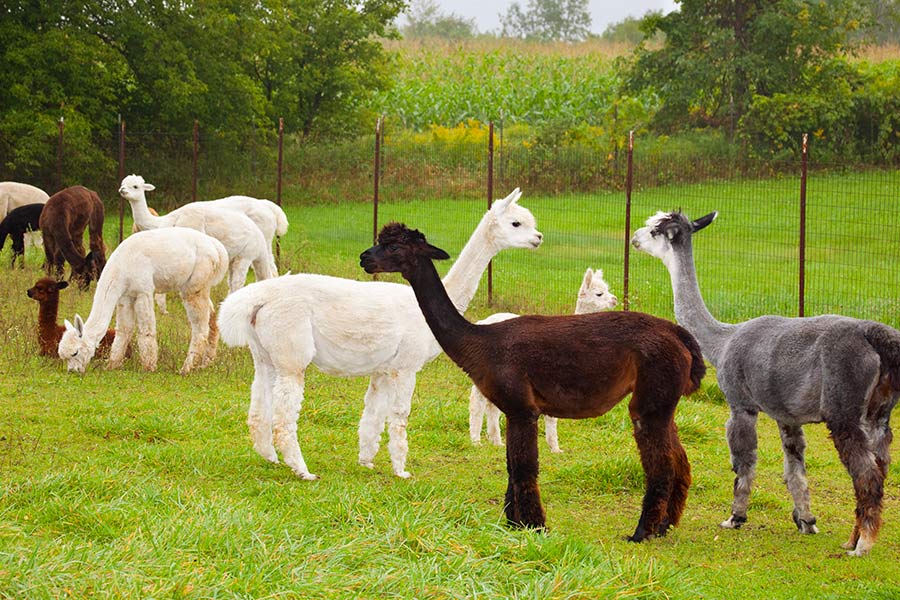Stomach Ulcers in Alpacas and Llamas

Stomach Ulcers in Alpacas and Llamas
By Stephen R. Purdy, DVM
Normal Stomach Anatomy
- 3 compartments:
-
- C1- 83% by volume of stomach contents (15- 25 liters)
- C2- 6% by volume (1- 2 liters)
- C1 and C2 contents freely intermix
- bicarbonate secreted in ventral saccules of C1 and C2 to buffer pH in C1
- C3- a tubular structure
- first 3/4 is glandular ~ saccules of C1 and C2
- last 1/4 has acid-secreting glands- ph 1.4- 2.0
- peristaltic contractions mix stomach contents with secreted acid
- very little is known about the control of acid secretion in camelids
- protective mechanisms preventing autodigestion of the stomach lining are thought to be similar to other species
- ulcers occur mostly in acid-secreting zone of C3 and upper duodenum
Clinical Signs Of Ulcers: alpacas and llamas are very stoic animals!
- depression/ lack of appetite
- ~1/3 of cases show colic- shifting weight, grinding teeth, frothing at the mouth, rolling, getting up and dow
- not often feveris
- decreased manure production
- may be obscured by other disease conditions which might be the cause of the ulcers
Proposed Mechanisms of Ulcer Formation in Camelids
- stress- serious or chronic diseases increase the incidence of ulcers
- high incidence with colic cases at referral hospitals
- found in animals dying of any cause with no premortem signs of ulcers
- complicated orthopedic problems- pain may predispose to major trauma, e.g. dog bites
- overcrowding
- travel- long distance, hot weather, and nervous temperament animals
- weaning- delay if cria has health problems
- isolation from other animals- have to see other camelids ( they are herd animals)
- glucocorticoids- cortisones- topical, oral or injectable can cause ulcer formation
- non-steroidal anti-inflammatory drugs such as Bute and Banamine
- not as often as in horses, but don’t use a long time
- bacteria- not isolated in lamas as in people
- excessive acid secretion- no evidence either way that this contributes to ulcer formation in camelids
- dietary causes?
- high grain diets?? – seen in cattle
- low incidence in S. America where little grain is fed
- small particle size pellets?? – causes ulcers in pigs
Diagnosis of Ulcers
- clinical signs
- no specific blood tests
- abdominal exploratory surgery- A bad idea in an already stressed animal
- dark stools indicating the presence of digested blood are not seen
- decreased bacteria and protozoa in C1 contents sample from stomach tube
- C1 pH < 4.0 on stomach tube sample
- abdominal tap is usually normal unless perforation has occurred
Differential Diagnoses:
- intestinal torsions- rare
- uterine torsion- last 60 days of gestation
- impactions- should see significant dehydration
- enemas in newborn crias could prevent
- abdominal tumors- rare
- intussusception- rare
- peritonitis- uncommon, except with perforating ulcers
- urinary tract problems- males- ruptured bladder/urethral stones-uncommon
- intra-abdominal abscesses- uncommon- abdominal tap shows increased WBCs, or possibly increased serum globulin level
- toxic plants- Rhododendron
- C1 stasis (lack of stomach motility)
- in adults off feed greater than 3- 4 days
- in crias with repeated tubing
- lactic acidosis- overeating grain- C1 stasis- low C1 pH
Management of Ulcers
- Oregon State University Vet School- most occur as secondary problems (this has also been my experience)
- some cases at Colorado State University Vet School have resulted in secondary pneumonia
- ulcers in newborns in New England
relatively high mortality, so treat aggressively!!!
- suppress acid production
- antihistamines (H2 blockers)
- Zantac (ranitidine)- perhaps the best drug for treatment of ulcers
- 0.75 mg/lb IM, subQ, or IV two times daily (once daily for prevention)
- not effective orally
- Prilosec (omeprazole)- good orally at 0.5 mg/lb PO BID (once daily for prevention)
- open capsule into 12 ml syringe (with tip end cut off) with KY and squirt into mouth
- Zantac (ranitidine)- perhaps the best drug for treatment of ulcers
- antihistamines (H2 blockers)
- nonspecific C3 protection- sucralfate (Carafate)- 10 mg/lb orally four times a day- not very effective in adults
- stress reduction!!!!!
- resolve the primary problem
- cohousing with herdmates
- IV fluids/ prophylactic antibiotics
- preventative treatment when a severe primary disease is present
- Zantac or Prilosec once daily
- do not let the treatment worsen the disease

